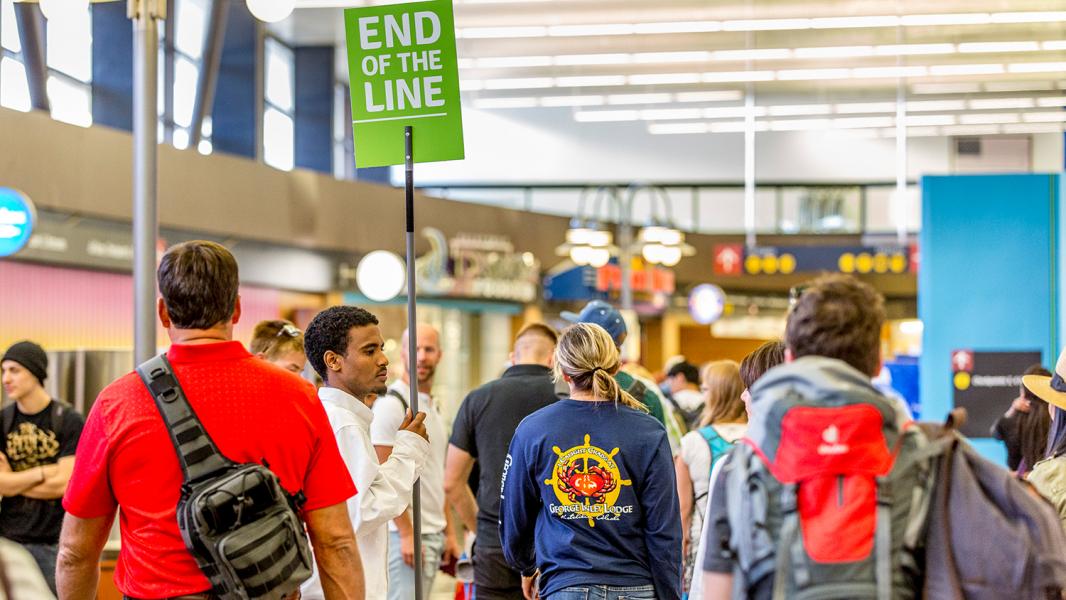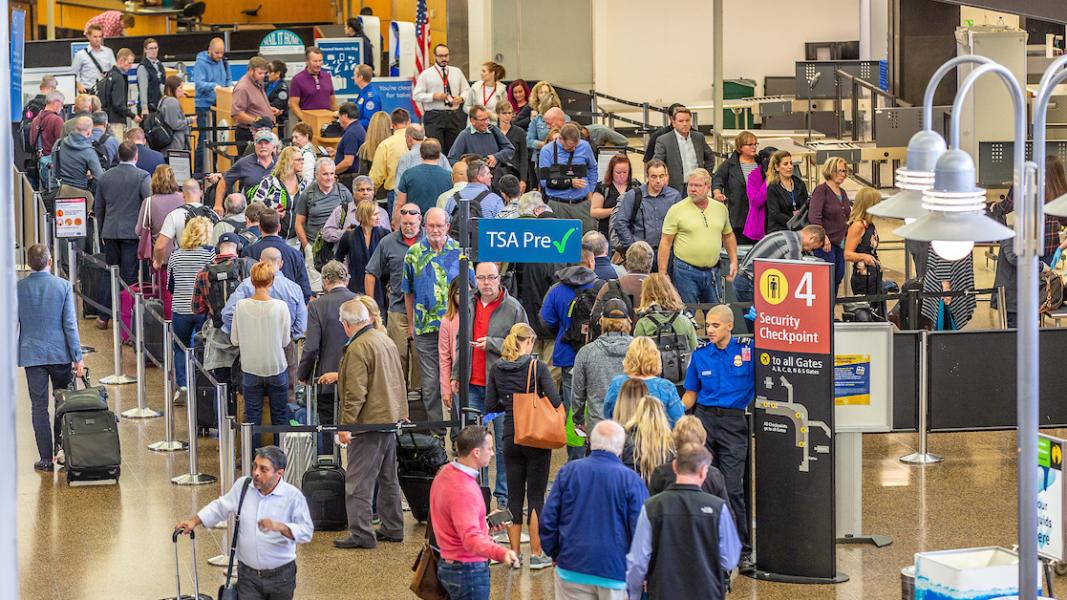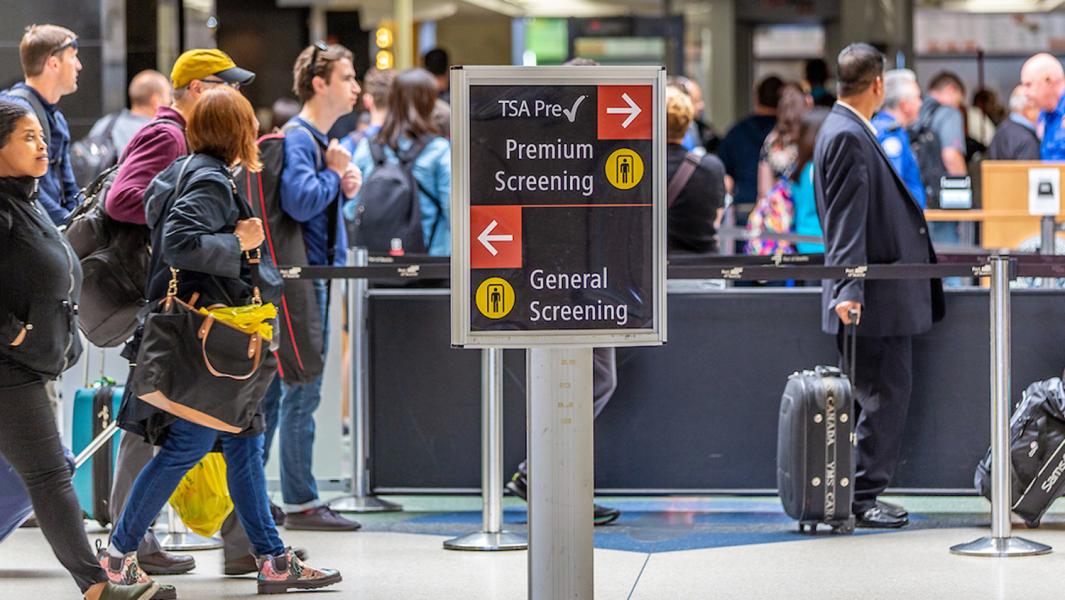
| Translations are available in Amharic, Arabic, Chinese, Spanish, and Vietnamese: | ||||
| ይህን ጦማር/ብሎግ በአማርኛ ያንብቡ | هذه المدونة باللغة العربية< | 阅读中文版博客 | Lea el blog en español | Đọc blog này bằng tiếng Việt |
You or someone you know may have experienced long, winding lines at the security checkpoints during one of your last visits to Seattle-Tacoma International Airport (SEA). SEA has a goal to get everyone through in less than 20 minutes, and the majority in less than 30 minutes. However, peak periods can be unpredictable, and you may find much longer waits especially in the mornings. Why does this happen? Does the airport plan for this?
Yes, SEA does plan ahead. The airport team works hard to be innovative, use creativity for the small space, and be prepared for last-minute, unpredictable challenges. Let’s dig into some of the details to help you understand.
Why do checkpoint lines meander all over the place?

It’s all about space. SEA just doesn’t have enough of it with more people traveling than ever. This terminal was designed back in the 1970s and there are more travelers now than planners ever expected back then. The airport does have plans for a new north terminal, part of theSustainable Airport Master Plan, but that’s not going to help you right now.
One of the biggest challenges is the physical layout of the terminal. SEA has one of the smallest footprints of a terminal space for any airport in the U.S. serving over 40 million passengers per year. Given those space constraints, the airport has to find imaginative and efficient ways to make it work.
Overall, SEA just doesn't have the space for checkpoint queues as do other airports. For example, the space in front of our largest checkpoint, 3, is about 7,000 square feet. At other airports, that might be their smallest checkpoint. For example, Las Vegas has 20,000 to 30,000 square feet of space for its largest checkpoints, and it has about the same amount of annual passenger volume.
In addition, SEA just can’t open the same amount of space because right next door there are airline ticket counters, and then the vehicle drives, and then the airport parking garage.
So, to manage peak periods the airport allows overflow lines to, what we might politely say, meander like a river. Staff makes sure lines don't block exits or escalator access for outbound passengers or clog ticketing areas for inbound travelers. For instance, the overflow line from Checkpoint3 (CP3) goes south around an escalator (avoiding travelers exiting from the B concourse and heading down escalators to the baggage claim), then back around to our breezeway in zigzag lanes behind the Delta ticket counters. (Yes, it can seem like an amusement park line!) CP2 has overflow in the same breezeway going north as there is nowhere for the line to go further south due to the wall between it and CP 1.
What happens in the worst-case scenario?
In the worst case, during peak periods when lines are the longest, SEA has evolved plans so that all travelers get into one line to start with, in front of CP3. This checkpoint has the most processing lanes so we can efficiently backup the overflow to the Skybridge and potentially into the garage where stanchions are set up. The strategy is for travelers to then be directed from this line to the other checkpoints as space becomes available; this is called ‘load balancing.’ For example, if CP2 is open, you’ll be pointed there. If there’s now space in CP3, you’ll go there, or CP4, go there. This avoids having overflow lines at each checkpoint that would interfere with ticketing areas and still be efficient. It looks long but typically moves fast. For those who need assistance, there are elevators available. If you have questions, check with our Pathfinders who organize the lines.

During busy peak hours, wait times can be up to 45-60 minutes. We appreciate everyone’s patience. Staff works hard to communicate what’s happening as best as they can. If you’ve got questions, ask Pathfinders or customer service staff in teal or grey shirts.
Don’t you know how many people are coming and you can prepare for that?
From the outside, this can seem like a straightforward task. The Transportation Security Administration (TSA) does work with the airlines to get passenger projections for every hour of the day. However, there are unpredictable variables. The biggest is guessing when a passenger will arrive. Their flight may depart at 10:00 a.m., but what time will they come? 8:00 a.m. or last minute at 9:00 a.m.? Or, somewhere in between? The difference in the wait times can vary dramatically from one 20 or 30-minute period to the next, so a rush of arrivals can slow lines down or a drop can speed things up. Plus, the numbers can change from projections when airlines sell new tickets or travelers cancel.
Why don’t you have all checkpoint lanes open during peak periods?
Just like other employers in the region, staffing is a challenge. The TSA is challenged to hire and retain employees in the robust economy of the Puget Sound region. We appreciate our TSA partners and the hard work they do every day (please give them a ‘thanks’ when you can). If they don’t have enough staff to open all of the checkpoint lanes, however, that condition diminishes the number of passengers TSA agents can safely screen. Remember, their job is to make sure your travels are safe. From a line standpoint, it’s like a funnel. TSA can only get through as many people as there are lanes open and balancing those shift times to serve the peak periods can create long wait times.
What about canines? Don’t they make things faster?
Yes, canine teams can help the speed of checkpoint lines. However, just like people, they need breaks too and there needs to be enough canine teams to efficiently staff a checkpoint. If there aren’t enough canines to rotate in and out, that can slow efficiency. Also, it takes time to setup the canine process in a line and that completely stops the line until they are ready. Typically canines are used at CP 3.
Why am I being directed to the longer checkpoint line? Is that correct?
It sounds counter-intuitive, but, yes, this direction is correct – the longest lines can be the fastest. The reason is more checkpoint lanes are open and the wait time is usually less. This scenario often happens at CP3, our largest checkpoint with nearly twice as many lanes.
The common misperception of how long it will take is due to the convergence of overflow lines in the breezeway between CP2 and CP3. While the line at CP2 may look shorter, it doesn’t have as many lanes and we typically see a longer wait. Pathfinders will direct travelers to CP3. A traveler may look at the line and think, ‘Hey, that line is a lot longer. You want me to go there?’ In reality, the wait is shorter and Pathfinders are on hand to let you know which line is fastest. You may choose whether or not to follow their guidance and get into whichever line you’d like, of course. Another challenge is our wait times listed on signage are ‘predictive.’ It’s hard to be exact for a real time. There are variables there, too. You might get behind someone who has a lot of items, or forgets to take off their shoes, or takes time to dig in their bag to get their ID or additional screening is needed. Add those factors to several people and now the wait time is longer. Sign up for a Trusted Traveler Program to speed up your time in the security line.
Can you add more TSA PreCheck lanes? Do you have too many TSA PreCheck lanes?

We get questions on both sides of this topic. For greatest efficiency, two checkpoints are set aside specifically for TSA Pre✓® — CP1 and CP4. That may seem like a lot of TSA PreCheck for five checkpoints, but remember, many more general screening lanes are available than the 25-30 percent dedicated to TSA PreCheck. You can also use virtual queuing with free SEA Spot Saver or paid option CLEAR. Whether you take advantage of expedited screening or not, overall, it reduces the number of travelers who go through general screening.
When necessary, during the longest lines, TSA will open typical PreCheck lanes to general lanes in order to help reduce waits.
What can I do to be prepared for potentially long lines?
Download the Fly SEA App on your smartphone to see real-time checkpoint wait times. Be prepared — print your boarding pass at home, and know what you can or cannot pack. Arrive early — be in the terminal two hours before a domestic flight and three hours before an international flight. It is better to get screened quickly and have time to wait (or sample new food and retail choices) than to be late and potentially miss your flight due to a long line.
Are you planning for anything to help the checkpoint situation?
SEA continues to plan and strategize more solutions for checkpoint queues. This summer, we’ve added additional staff, including additional full-time Pathfinders . Also, we’ve hired more staff through a private customer service contractor whose employees manage queues and help TSA staff with divesting duties — directing travelers on what to keep in your bag, and what needs to go in a bin through the scanner. Using contractors for these duties allows TSA to use agents to open additional lanes.
Looking ahead, Upgrade SEA is a $4.6 billion capital improvement program that will be improving customer experience throughout the airport. A pair of projects will add additional checkpoint lanes. Specifically, the Checkpoint 1 Relocation Project is a creative way to add more space to checkpoint use. This will relocate CP1 to the bag claim level for more and larger lanes, more queuing space, and more efficient through-put. The SEA Gateway Project will also add lanes to CP5 in conjunction with the upgrade to the north end of the ticketing area with Alaska Airlines.
We need significant investments to meet future needs for customer service, safety, sustainability, and efficiency. The Port of Seattle and FAA are conducting an environmental review of more than 30 Sustainable Airport Master Plan (SAMP) Near-Term Projects to do just that. Highlights include a new terminal with 19 gates and an automated people mover with three stations connecting the rental car facility, new terminal, and main terminal.







